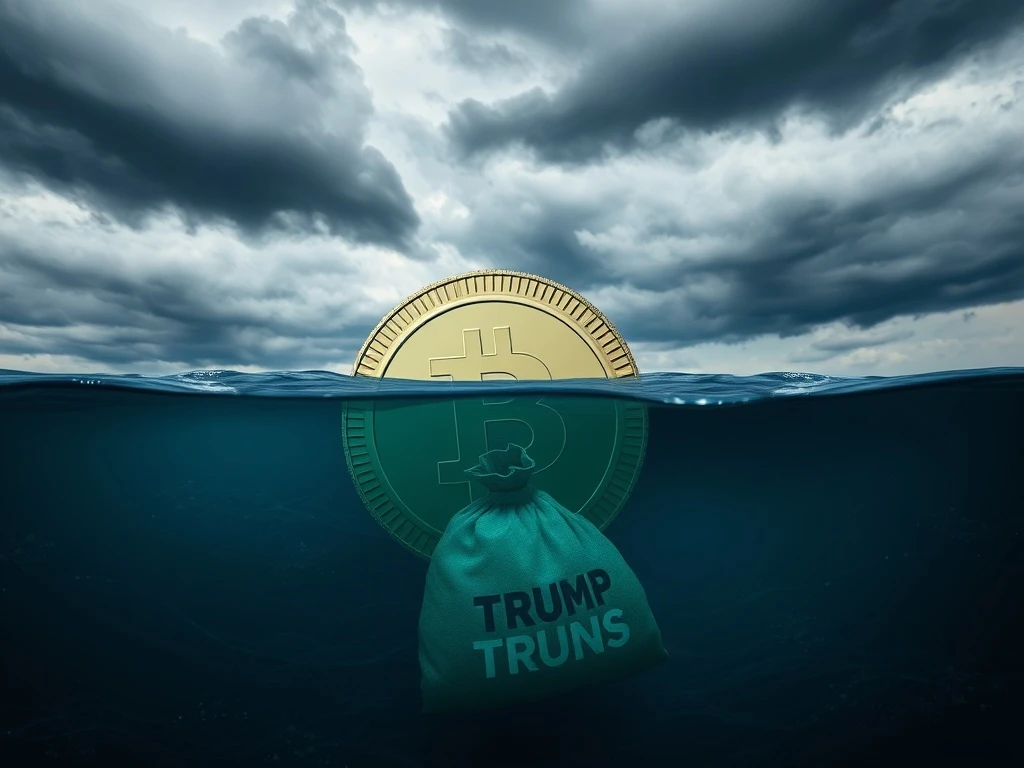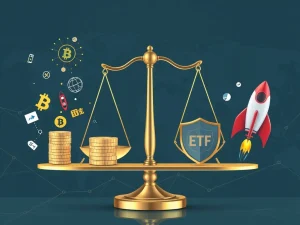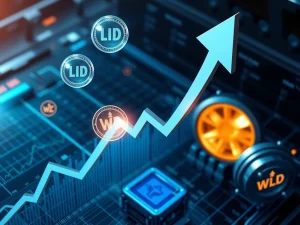TRUMP Memecoin: Unveiling the Alarming Truth Behind $324M in Fees and No Roadmap

The cryptocurrency world is no stranger to volatility, but the recent surge of the TRUMP memecoin has sparked a new level of debate and concern. How did a token with no white paper, no clear purpose, and no publicly named development team reach a multi-billion-dollar valuation? More importantly, what’s truly going on behind the scenes with its massive fees and questionable beneficiaries? For anyone navigating the exciting yet treacherous waters of digital assets, understanding the TRUMP phenomenon is crucial.
The Unprecedented Rise of the TRUMP Memecoin
Launched on January 17, 2025, on the Solana blockchain, the TRUMP-themed memecoin quickly ascended to become one of the most talked-about and controversial political tokens. Despite its marketing tie to Donald Trump, the project initially disclaimed any political or financial objectives, presenting itself as purely speculative.
Within a mere 48 hours of its launch, the Official Trump (TRUMP) token soared to a market capitalization exceeding $27 billion, briefly entering the top 20 cryptocurrencies globally. This meteoric rise, however, was followed by an equally dramatic fall, with the token crashing by nearly 70% soon after its peak. This rapid boom-and-bust cycle is a stark reminder of the extreme volatility inherent in the memecoin market, often driven by hype rather than fundamentals.
What makes the TRUMP memecoin particularly unusual is its complete lack of transparency. There’s no white paper outlining its vision, no publicly identified development team, and no long-term roadmap. These missing elements raise significant red flags concerning investor protection and the project’s long-term viability. Meanwhile, the token has generated hundreds of millions in trading fees, primarily benefiting two entities: CIC Digital and Fight Fight Fight.
- Did you know? Donald Trump’s wife, Melania, launched her own memecoin, Official Melania Meme (MELANIA), just 48 hours after TRUMP, adding another layer to the political token landscape.
The Startling TRUMP Memecoin Controversy: Who Benefits?
The distribution of the TRUMP token’s supply and profits has ignited a significant memecoin controversy, raising ethical and legal questions about potential investor exploitation. The project’s structure is highly unusual, even by crypto standards.
The token’s smart contract is designed to direct a large share of trading fees – estimated to be over $320 million and still accumulating – toward two opaque entities: CIC Digital and Fight Fight Fight. These groups are widely believed to be connected to Trump’s allies, though no formal declarations have been made. According to NBC News, these two entities reportedly control nearly 80% of the token supply, concentrating power and profits in very few hands.
The controversy deepened when Donald Trump himself hosted a private dinner in May for top token holders at Mar-a-Lago. Ethics watchdogs swiftly condemned the event. Senator Jeff Merkley famously described Trump’s TRUMP-token dinner as “the Mount Everest of American corruption,” criticizing the seven-figure pay-to-dine scheme as an ethical outrage.
- Did you know? Seats at Trump’s private TRUMP “VIP dinner” reportedly cost buyers over $1 million each, fueling concerns about crypto being used as a tool for political influence-buying.
High Fees, No Utility: A Dangerous Trend for Political Tokens
While high fees are not entirely uncommon in the memecoin space, the TRUMP token’s fee structure stands out because there’s no apparent reinvestment into the token’s ecosystem. Unlike legitimate projects, there’s no team actively building a decentralized application (DApp), launching staking mechanisms, or even offering governance votes to holders. This distinguishes it sharply from other political tokens that might genuinely contribute to causes or fund real-world campaigns.
The TRUMP token’s primary purpose appears limited to speculative trading and meme-based branding. It falls squarely into the category of memecoins with no inherent utility, projects that gain attention based purely on narrative and hype but offer no underlying substance. Despite this, it managed to reach a vast audience, many of whom were retail buyers who ultimately suffered significant losses as the token lost more than half its value within weeks of its peak.
TRUMP Coin Price vs. Roadmap: Is There a Plan or Just a Pump?
When comparing the TRUMP coin price to any semblance of a roadmap, the disparity is enormous. The token’s rapid price appreciation was fueled primarily by election-year hype, viral online memes, and influencer campaigns, rather than any fundamental value or development. There is no public evidence of future plans for protocol upgrades, community proposals, utility integration, or even long-term liquidity management.
In the crypto world, it’s not unusual for projects with no clear roadmap to gain temporary traction. However, history consistently shows that once the initial hype dissipates, memecoins lacking utility often implode, taking retail portfolios down with them. The TRUMP token’s trajectory fits this pattern, serving as a cautionary tale for those chasing quick gains.
- Did you know? Over 67,000 people reportedly bought TRUMP using debit cards, suggesting a significant portion of its holders were crypto newcomers, indicating a potential for predatory targeting.
How to Research Memecoins: A Vital Checklist to Avoid Crypto Scams
The TRUMP case underscores the critical importance of due diligence before investing in any memecoin. Knowing how to research these highly volatile assets can help investors steer clear of emotionally charged, high-risk tokens like TRUMP and protect themselves from potential crypto scams. Here’s a quick checklist to guide your research:
- Is there a roadmap or white paper? A legitimate project typically provides these documents outlining its vision, technology, and future plans. TRUMP has none.
- Are the founders known and public? Transparency about the development team builds trust. TRUMP’s creators remain anonymous.
- Is there real-world utility or DApp integration? Does the token have a function beyond speculation? TRUMP offers no utility.
- Is the token fairly distributed? Highly concentrated holdings can indicate insider control and manipulation. Approximately 80% of TRUMP’s supply is held by two insider-linked wallets.
- Is the fee structure reasonable and transparent? High fees without clear reinvestment or purpose are a major red flag. TRUMP’s fees are high, and their destination is opaque.
Failing multiple points on this checklist should serve as a bright red flag, especially in a year where crypto red flags for investors are becoming increasingly common. The US Securities and Exchange Commission (SEC) staff has warned that memecoins like TRUMP resemble collectibles, lack investor protections, and are driven purely by speculation.
The Rise of Political Tokens and Growing Investor Risk
The trend of political tokens in 2025 is more than a fleeting phenomenon; it’s a discernible pattern. From Argentina’s LIBRA token endorsement to smaller, decentralized campaigns themed around political figures or movements, these tokens tap into tribalism and cultural identity as a form of market power. However, as the TRUMP example vividly illustrates, most are long on narrative and short on transparency or tangible value.
Without clear roadmaps, known contributors, or robust legal compliance, these tokens operate in a regulatory gray zone. This often leaves retail investors holding the bag when market sentiment shifts or when the hype inevitably dies down, increasing their investor risk significantly.
A Familiar Pattern: From Hype to Fallout – Protecting Against Crypto Scams
You’ve likely seen this pattern before. Crypto history is replete with cautionary tales, from SafeMoon to Unicoin, whose founders were recently charged in a $100-million fraud case. Tokens that explode in popularity often collapse just as quickly, especially when there’s no real technology or utility underpinning them.
For investors, the TRUMP token serves as a timely reminder that hype cycles are not sustainable strategies. Its lack of transparency, disproportionate insider holdings, and nonexistent roadmap place it in the same high-risk category as past boom-and-bust meme tokens with no utility. It’s a stark warning against falling victim to quick-rich schemes that often turn out to be elaborate crypto scams.
- Did you know? Roughly 97% of memecoins fail entirely, and 60% of memecoin holders treat them as short-term gambles, highlighting the speculative nature and high risk involved.
Regulatory Crackdown: MEME and COIN Acts Signal Action
As memecoins like TRUMP move hundreds of millions of dollars without accountability, global regulators are taking notice. The SEC’s 2025 task force and updated guidance on token classification are expected to bring greater scrutiny to politically adjacent tokens. If found to be unregistered securities or deceptive schemes, future enforcement actions could follow.
In the United States, proposed legislation aims to address these concerns directly:
- The proposed Modern Emoluments and Malfeasance Enforcement (MEME) Act seeks to prohibit political figures and their families from creating or endorsing digital tokens, aiming to prevent conflicts of interest and covert fundraising.
- Complementing this, the newly introduced Curbing Officials’ Income and Nondisclosure (COIN Act) would bar the president, vice president, members of Congress, executive branch employees, and their immediate families from issuing, promoting, or profiting from any digital asset, including memecoins, non-fungible tokens (NFTs), and stablecoins, during their tenure and for two years thereafter. It also mandates real-time disclosure of crypto transactions above $1,000, with penalties including fines and up to five years in prison.
Simultaneously, broader initiatives like the GENIUS and STABLE Acts are working to establish comprehensive frameworks for crypto asset oversight, covering transparency, reserve requirements, and Anti-Money Laundering (AML) compliance. Internationally, regulators are also acting, most notably with the EU’s Markets in Crypto-Assets (MiCA) law and the Financial Action Task Force’s (FATF) call for stricter crypto AML enforcement, aiming to curb misuse across borders. This global regulatory push toward AML enforcement, exchange disclosure, and decentralized autonomous organization (DAO) liability may eventually close some of the gaps currently exploited by anonymous token creators.
Conclusion: Navigating the Memecoin Minefield
The TRUMP memecoin saga is a powerful reminder of the inherent dangers in the unregulated corners of the crypto market. Its rapid ascent, followed by a sharp decline, coupled with a lack of transparency and a controversial fee structure, highlights the significant investor risk associated with projects that prioritize hype over utility. While the allure of quick profits can be strong, the TRUMP case vividly demonstrates that a lack of fundamentals, insider control, and the absence of a clear roadmap are all bright red flags. As regulators begin to tighten their grip on the crypto space, particularly concerning political tokens and potential crypto scams, it becomes even more crucial for investors to exercise extreme caution, conduct thorough due diligence, and prioritize projects with clear utility, transparent teams, and robust roadmaps. Your financial future depends on it.









